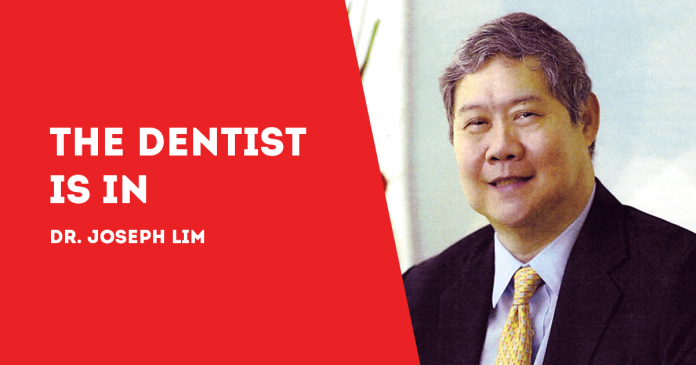
(By Dr. Joseph D. Lim and Dr. Kenneth Lester Lim, BS-MMG, DDM, MSc-OI)
AT ONE TIME or another, we have experienced gum disease.
It’s a condition which, according to the Department of Health’s Dental Health Program, affects nearly eight in 10 or 78 percent of Filipinos.
Gum disease happens when dental plaque is not removed regularly. The plaque – a thin film on teeth that comes from bacteria – can accumulate between the teeth and around the gums.
In its mild form – gingivitis – gum disease results in redness, swelling, and bleeding. If left untreated, gingivitis can lead to periodontitis, a more serious form of gum disease. It’s called by dentists “deep gum disease”.
Worldwide, it is the 11th most common disease in the world.
In America, deep gum disease is the second most widespread oral disease next to tooth decay. It affects more than 47 percent of American adults over the age of 30. By the age of 65 and older, 64 percent of them have either moderate or severe periodontitis.
It’s not for nothing that it’s called deep gum disease. It is in fact an infection not on the gum surface but deep below.
Going deep, it’s hard to detect. Severe tooth pain usually indicates deep gum disease.
On the surface, gingivitis or gum inflammation is quite obvious on the visible part of the gum. Bacteria however move below the gumline into pockets near the tooth root. There they do the most havoc, eroding the structures that hold the tooth. Because it manifests no symptoms, periodontitis generally goes undetected until about the age of 40 or 50.
By that time, if it’s not treated, tooth loss is highly likely. By that time too, a steady stream of bacteria may have entered your bloodstream for many years.
Some of the bacteria will go to the arteries, the pancreas or the liver, even to the brain. Which is periodontitis has been linked to cardiovascular disease, diabetes, Alzheimer’s, obesity, cancers, rheumatoid arthritis, Parkinson’s, pneumonia and complications in pregnancy.
At the onset of periodontitis, the treatment consists of scaling and root planing that scrape microbes off the lower tooth surface; this is just above and below the gum line. At the later, more serious stages, surgical treatment may be recommended when the root surfaces is cleaned.
There are many ways to avoid going to surgery, or even scaling and root planing. And that’s to take very good care of your teeth, gums and oral health.
Brush, floss and gargle with a mouth wash – at least twice a day or, ideally, after each meal. Go to the dentists at least twice a year for cleaning and general check up.
***
Dr. Joseph D. Lim, Ed. D., is the former Associate Dean of the College of Dentistry, University of the East; former Dean, College of Dentistry, National University; Past President and Honorary Fellow of the Asian Oral Implant Academy; Honorary Fellow of the Japan College of Oral Implantologists; Honorary Life Member of the Thai Association of Dental Implantology; and Founding Chairman of the Philippine College of Oral Implantologists. For questions on dental health, e-mail jdlim2008@gmail.com or text 0917-8591515.
***
Dr. Kenneth Lester Lim, BS-MMG, DDM, MSc-OI, graduated Doctor of Dental Medicine, University of the Philippines, College of Dentistry, Manila, 2011; Bachelor of Science in Marketing Management, De la Salle University, Manila, 2002; and Master of Science (MSc.) in Oral Implantology, Goethe University, Frankfurt, Germany, 2019. He is an Associate Professor; Fellow, International Congress of Oral Implantologists; Member, American Academy of Implant Dentistry and Fellow, Philippine College of Oral Implantologists. For questions on dental health, e-mail limdentalcenter@gmail.com./PN



